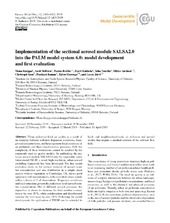| dc.contributor.author | Kurppa, Mona | |
| dc.contributor.author | Hellsten, Antti | |
| dc.contributor.author | Roldin, Pontus | |
| dc.contributor.author | Kokkola, Harri | |
| dc.contributor.author | Tonttila, Juha | |
| dc.contributor.author | Auvinen, Mikko | |
| dc.contributor.author | Kent, Christoph | |
| dc.contributor.author | Kumar, Prashant | |
| dc.contributor.author | Maronga, Bjørn | |
| dc.contributor.author | Järvi, Leena | |
| dc.date.accessioned | 2020-08-10T13:13:31Z | |
| dc.date.available | 2020-08-10T13:13:31Z | |
| dc.date.issued | 2019-04-11 | |
| dc.Published | Kurppa, Hellsten, Roldin P, Kokkola H, Tonttila J, Auvinen, Kent, Kumar P, Maronga B, Järvi L. Implementation of the sectional aerosol module SALSA2.0 into the PALM model system 6.0: model development and first evaluation. Geoscientific Model Development. 2019;12(4):1403-1422 | eng |
| dc.identifier.issn | 1991-9603 | en_US |
| dc.identifier.issn | 1991-959X | en_US |
| dc.identifier.uri | https://hdl.handle.net/1956/23622 | |
| dc.description.abstract | Urban pedestrian-level air quality is a result of an interplay between turbulent dispersion conditions, background concentrations, and heterogeneous local emissions of air pollutants and their transformation processes. Still, the complexity of these interactions cannot be resolved by the commonly used air quality models. By embedding the sectional aerosol module SALSA2.0 into the large-eddy simulation model PALM, a novel, high-resolution, urban aerosol modelling framework has been developed. The first model evaluation study on the vertical variation of aerosol number concentration and size distribution in a simple street canyon without vegetation in Cambridge, UK, shows good agreement with measurements, with simulated values mainly within a factor of 2 of observations. Dispersion conditions and local emissions govern the pedestrian-level aerosol number concentrations. Out of different aerosol processes, dry deposition is shown to decrease the total number concentration by over 20 %, while condensation and dissolutional increase the total mass by over 10 %. Following the model development, the application of PALM can be extended to local- and neighbourhood-scale air pollution and aerosol studies that require a detailed solution of the ambient flow field. | en_US |
| dc.language.iso | eng | eng |
| dc.publisher | Copernicus | en_US |
| dc.rights | Attribution CC BY | eng |
| dc.rights.uri | http://creativecommons.org/licenses/by/4.0/ | eng |
| dc.title | Implementation of the sectional aerosol module SALSA2.0 into the PALM model system 6.0: model development and first evaluation | en_US |
| dc.type | Peer reviewed | |
| dc.type | Journal article | |
| dc.date.updated | 2020-01-14T14:51:35Z | |
| dc.description.version | publishedVersion | en_US |
| dc.rights.holder | Copyright 2019 The Authors | en_US |
| dc.identifier.doi | https://doi.org/10.5194/gmd-12-1403-2019 | |
| dc.identifier.cristin | 1714624 | |
| dc.source.journal | Geoscientific Model Development | |

